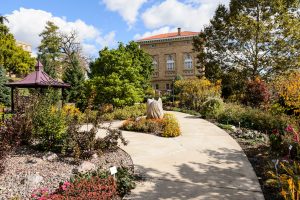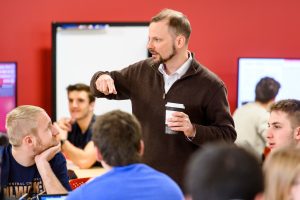A message from Lois Brooks, vice provost for information technology and chief information officer:
I first set foot on the UW–Madison campus 5 years ago in the summer of 2018. I remember walking around the campus for the first time and seeing the Botany Garden on University Avenue, right in the heart of campus, and feeling excited to be at a university that would plant a garden on such prime real estate. I’ve walked through that garden so many times since then, taking an extra few minutes while walking across campus to appreciate the seasonal changes in this quiet oasis.

At the time, we were preparing to make some structural changes in the Division of Information Technology (DoIT) and in how we worked with the university IT community. During my initial listening sessions, I heard a lot about how we needed to enable better communication and collaboration, clarify the services catalog and move away from the division’s internal economy (my apologies for any distress I’ve caused with that last memory).
Looking back 5 years and 1 pandemic later, I see a lot of progress that should make us all proud. We’ve made tremendous progress on technology investments, enhanced campus cybersecurity and infrastructure, strengthened our partnerships, and invested in building our community. Oh, and we replaced that infernal internal economy.
As the new academic year begins, I thought it would be worthwhile to look back at the ground we’ve covered together over the last 5 years. It’s not an exhaustive list (we’ve accomplished too much to list in 1 blog), but they illustrate what makes this university — and the people who power it — special in the world of higher ed information technology.
Making our university more cybersecure
These days, cybersecurity is foremost on the mind of anyone in technology leadership in higher education. Horror stories about cyberattacks and breaches are not hard to find, even at large, well-resourced institutions. I’ve written elsewhere about how the very things that make being on a university campus a wonderful experience also make it challenging to secure. Given that backdrop, I’m proud of the way we’ve reinforced our infrastructure and stepped up our practices.
We launched campuswide single sign-on and multi-factor authentication for vital campus services in 2019. It may be hard for some to remember now what a big lift that was. Creating and implementing a system that would securely meet the needs of our students, faculty and staff, and then training tens of thousands of people with widely ranging technological skill levels — in multiple languages — was an enormous undertaking. But there was never any doubt that we needed to do it. As a result, our campus is significantly more secure than it was 5 years ago.
Of course, cybersecurity is a process, not a finish line. Following our Cybersecurity Risk Management policy, we’ve implemented a modern, forward-looking cybersecurity strategy that reduces our surface area for attacks and hardens our defenses while prioritizing consistency, operational excellence, transparency and education. This approach has helped us accomplish a lot, from improving our active directory service to upgrading our email security, implementing campuswide cybersecurity training, and upgrading our network security and connectivity.
Enhancing our operations & services
Starting in 2018, we began a process to reorganize DoIT to better serve the university’s mission. By organizing around 3 focus areas — university mission, strategic operations and core services — we realigned our services and technologies to reduce unnecessary complexity and better support the university’s research, teaching and learning, and business initiatives.
Teams from across the division have made a lot of progress to ensure UW–Madison always has a best-in-class IT enterprise:
- We simplified and streamlined DoIT’s finances by eliminating the internal chargeback system. This was a big win for us. It reduced the administrative burden on our staff, increased cost transparency, enabled greater collaboration and communication, and improved morale both inside the division and for our campus partners.
- We identified our IT Strategic Priorities for the campus, organizing our efforts around the priorities of people, research, learner success, administrative transformation and cybersecurity.
-

Dan Rosenberg, then a DoIT operations technologist, upgrades server hardware in DoIT’s data center in April 2020. (Photo by Jeff Miller / UW–Madison) We completed major upgrades to the university’s wireless network, campus cloud infrastructure, Student Information System, as well as the Universities of Wisconsin Shared Financial System.
- We designed and launched ResearchDrive and made major investments in computation and data center infrastructure to support research.
- We successfully merged the Administrative Information Management Services (AIMS) with DoIT, allowing us to improve the efficiency and effectiveness of our IT services.
- We enabled a successful shift to remote work and teaching, offering new enterprise services like Zoom, ramping up our virtual private networking capacity, re-architecting the network to allow for improved throughput and security, and reinventing how the Help Desk supports our university community.
- We have been and continue to be a key partner in the Universities of Wisconsin Administrative Transformation Program, supporting the migration to Workday, developing a new data strategy to support the university’s business needs, modernizing our data interoperability and access, and supporting ancillary systems.
Strengthening our partnerships
We can’t do our best work without close collaboration and partnerships. Over the last 5 years, we’ve forged new partnerships and strengthened our existing relationships.
I’m particularly grateful for the work of UW IT Connects over the years to break down silos, share knowledge, develop leaders and build strong relationships within the information and technology communities. At a university as vast and diverse as UW–Madison, it is so important to have a collaborative organization like IT Connects building bridges, facilitating communication and bringing the distributed information and technology communities together.
In the division, our partnerships are how we get things done and help make the Wisconsin Idea possible. We’ve had several fruitful partnerships in the last few years, including:
- The Advisory Committee on Research Computing, a partnership that includes our Center for High Throughput Computing and has led to a renewed investment in UW–Madison’s research computing hardware, enabling a significant upgrade to our research cyberinfrastructure. Their efforts build upon our earlier success in launching ResearchDrive.
-

Dan Pell, then a teaching and learning technology consultant with DoIT, talks with students in a Material Science & Engineering class in March 2019. (Photo by Bryce Richter / UW—Madison) The Wisconsin IceCube Particle Astrophysics Center, which partnered with DoIT’s Data Center team in 2018 to relocate research computing infrastructure to the first off-campus, leased hosting facility at OneNeck IT Services LLC in Fitchburg. As an anchor partner, IceCube helps DoIT test the research network limits while hunting for high-energy neutrinos.
- Student Affairs has honored several of DoIT’s departments and staff with their Outstanding Student Affairs Partner Award in recognition of the work we’ve accomplished together.
- The Division for Teaching and Learning partners closely with DoIT Academic Technology to ensure that UW’s students and instructors have what they need to be successful in the classroom, lab, and online learning.
- The list of our partnerships keeps going: Facilities Planning & Management, the Office of Business Engagement, University Health Services, the UW–Madison schools and colleges, and more.
Investing in our people
As I’ve mentioned, none of these accomplishments would have been possible without the dedicated people of the UW–Madison IT community. I view it as one of my chief responsibilities to help foster an inclusive and diverse IT community that promotes a sense of belonging and mutual respect. We know people are happiest when their work is valued, when they feel part of the community, and when they feel seen and heard. I’m not going to say we’re always successful in our efforts toward those goals, but I do think we’re making progress.

We’ve focused on developing our climate, improving recruitment and retention processes, increasing professional development opportunities, and fine-tuning onboarding techniques such as mentoring and training. We’ve also worked to make our employee pay more equitable and competitive in the marketplace.
I’m gratified by how earnestly we’ve all taken this up, both in DoIT and across the university. One notable effort is our inaugural learning analytics microgrants, which aim to encourage innovation, exploration and iteration in teaching and learning that supports diversity, equity, inclusion and belonging. We’ve also worked to take care of our student employees — a critical part of how UW’s IT systems function and an essential piece of our talent pipeline. That’s especially true at the DoIT Help Desk, where we recently increased the minimum student wage to $15 per hour.
I know I’ve left out many significant accomplishments from the past 5 years, but this should certainly provide a good picture of the breadth and depth of our work. As we turn to face the challenges and opportunities of the next 5 years, let these achievements fill us with energy and encouragement. Because together we really can do amazing things.
Best,
Lois


